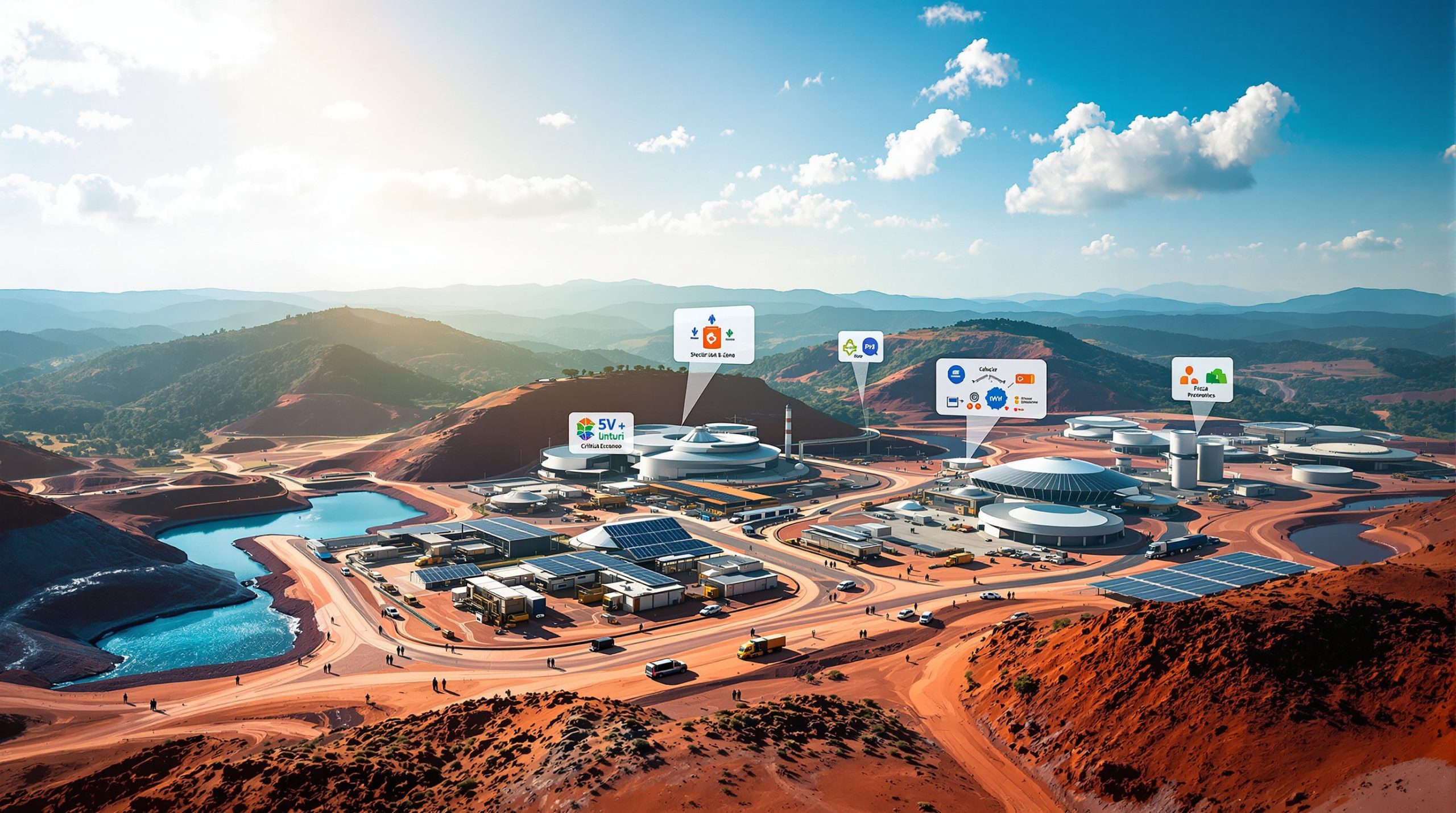Understanding the Sweetwater Uranium Complex Fast-Track Permitting Process
The Sweetwater Uranium Complex has received a significant boost through its designation for expedited permitting under a federal initiative aimed at streamlining critical mineral project development. This fast-track process represents a strategic shift in how uranium production facilities are approved in the United States, with potential to significantly reduce regulatory timelines while maintaining environmental standards.
This designation positions the complex as a cornerstone of America's uranium production strategy, creating a pathway for more efficient development of domestic uranium resources at a time when energy independence has become increasingly important. Growing uranium market volatility has further emphasized the need for stable domestic production capabilities.
The FAST-41 Framework
The fast-track designation falls under the Federal Permitting Improvement Act (FAST-41), which establishes a governance structure and procedures specifically designed to expedite infrastructure projects deemed to be of national importance. This framework helps coordinate multiple federal agencies that might otherwise create bottlenecks in the permitting process.
By centralizing oversight and creating a more streamlined permitting guide, the FAST-41 designation represents a significant advantage for development of the Sweetwater Uranium Complex and similar critical mineral projects.
Why the Sweetwater Uranium Complex Received Fast-Track Status
Strategic Importance to U.S. Mineral Security
The Sweetwater Uranium Complex was strategically selected by the US Federal Permitting Improvement Steering Council for expedited permitting as part of a broader national strategy to enhance domestic critical mineral production. As noted in Mining Technology (August 6, 2025), this designation stems from an Executive Order designed to "bolster US mineral production by expediting the federal permitting process for critical mineral projects."
This executive-level prioritization underscores uranium's importance in national security frameworks and highlights the strategic value of domestic production capacity.
Critical Role in Nuclear Fuel Independence
Fast-tracking the Sweetwater complex directly supports the United States' goals of establishing reliable infrastructure for nuclear fuel independence. Amir Adnani, President and CEO of Uranium Energy Corporation, emphasized this point when he stated, "Sweetwater's selection under FAST-41 reinforces its national importance as a key project to achieve the United States' goals of establishing reliable infrastructure, supporting nuclear fuel independence" (Mining Technology, August 6, 2025).
As global competition for energy resources intensifies, this project represents a significant step toward reducing American dependence on foreign uranium supplies, which has long been a vulnerability in the domestic energy landscape. The recent US uranium imports ban on Russian material has further emphasized the need for domestic production.
Dual-Feed Processing Capability
The complex's unique dual-feed processing capability makes it particularly valuable to national interests. Upon completion of the permitting initiative, Sweetwater will become the largest licensed uranium production facility in the United States, with capacity to process both conventional ore and in-situ recovery (ISR) resin.
This technological flexibility provides important resilience in the uranium supply chain, allowing the facility to adapt to changing market conditions and resource availability.
How the Fast-Track Permitting Process Works
Federal Agency Coordination
The Bureau of Land Management, operating under the Department of the Interior, will serve as the lead agency overseeing the federal permitting process for the Sweetwater Uranium Complex. This centralized management approach helps eliminate redundancies and streamline approvals across various regulatory bodies that would otherwise need to conduct sequential reviews.
By consolidating oversight under a single lead agency, the process avoids the common challenges of interagency conflicts and inconsistent timelines that have historically delayed critical mineral projects.
Concurrent Review Procedures
While maintaining environmental and safety standards, the FAST-41 framework enables concurrent reviews from multiple agencies rather than sequential assessments. This parallel processing approach can significantly reduce overall permitting timelines without compromising the thoroughness of regulatory oversight.
This methodology represents a process innovation rather than a reduction in standards, allowing for more efficient use of government resources while maintaining environmental protections.
Accountability Mechanisms
The fast-track permitting process includes enhanced accountability mechanisms, including more transparent timelines and clear responsibility assignments among participating agencies. These mechanisms help prevent regulatory delays that have historically plagued uranium and other critical mineral projects in the United States.
Key Changes Enabled by Fast-Track Permitting
Implementation of In-Situ Recovery Mining
Uranium Energy Corporation's primary goal with this fast-tracking is to implement in-situ recovery (ISR) mining within the current mine permit boundary at the Sweetwater complex. ISR represents a modern approach to uranium extraction that differs significantly from conventional mining methods.
In ISR mining, a solution is injected into uranium-bearing formations to dissolve the uranium in place. The uranium-rich solution is then pumped to the surface for processing. This method avoids the need for traditional excavation, significantly reducing surface disturbance and many ISR environmental benefits associated with conventional mining.
Expansion to Adjacent Federal Lands
The expedited permitting will also facilitate expansion of mining operations to include adjacent ISR-amenable deposits located on federally managed lands. According to Reuters, this expansion represents a significant increase in accessible uranium resources within the project's operational footprint.
This expansion capability demonstrates how the fast-track process can unlock additional value from existing uranium assets through more efficient permitting of logical extensions to current operations.
Transformation into a Hub-and-Spoke Production Platform
The Sweetwater complex will become Uranium Energy Corporation's third hub-and-spoke production platform, joining operational advancements already underway in Wyoming's Powder River Basin and South Texas (Mining Technology, August 6, 2025). This integrated approach optimizes resource utilization and processing efficiency.
The hub-and-spoke model centralizes processing at the Sweetwater facility while allowing for multiple satellite production sites, creating economies of scale and operational efficiencies not possible with standalone production sites.
Technical Capabilities of the Sweetwater Complex
Sweetwater Processing Plant Specifications
The Sweetwater Processing Plant stands as a centerpiece of the complex with impressive technical specifications. According to Mining Technology (August 6, 2025), it is a fully licensed conventional uranium mill with a processing capacity of 3,000 tonnes per day. This substantial throughput capacity positions it as one of the most significant uranium processing facilities in the United States.
The plant's existing infrastructure provides a valuable foundation for expanded operations, representing a significant capital asset that would require years and substantial investment to replicate from scratch.
Production Capacity After Permitting
Upon completion of the ISR permitting initiative, the Sweetwater complex will achieve a licensed production capacity of 4.1 million pounds per annum of triuranium octoxide (U₃O₈) according to Mining Technology (August 6, 2025). This output level will make it the largest uranium production facility in the country.
This production volume represents a significant percentage of current U.S. uranium demand, potentially reducing import dependency and enhancing energy security.
Dual-Feed Processing Technology
The complex's dual-feed capability allows it to process both conventional mined ore and resin from in-situ recovery operations. This technological flexibility maximizes efficiency and allows for adaptation to varying market conditions and resource characteristics.
The ability to switch between feedstock types provides important operational resilience, allowing the facility to optimize production based on changing market conditions, resource availability, and economic factors.
Ownership and Investment History
Acquisition from Rio Tinto
In December 2024, Uranium Energy Corporation finalized the acquisition of Rio Tinto's Wyoming uranium assets, including the Sweetwater plant and associated mining properties (Mining Technology, August 6, 2025). This strategic purchase represented a significant consolidation within the U.S. uranium sector.
The transaction transferred ownership of these assets from a diversified global mining company to a specialized uranium producer with a strategic focus on U.S. production, signaling a shift toward more focused development of domestic uranium resources.
Investment Value and Financing
The $175.4 million transaction was financed through Uranium Energy's available liquidity, demonstrating the company's financial strength and commitment to expanding its uranium production portfolio (Mining Technology, August 6, 2025). Financial advisors for the acquisition included Goldman Sachs & Co. and Rothschild & Co., with legal counsel from Holland & Hart and McMillan.
This significant investment reflects growing confidence in the U.S. uranium sector, particularly as regulatory reforms like the fast-track permitting process reduce development timelines and investment risks.
Strategic Portfolio Integration
The Sweetwater complex complements Uranium Energy Corporation's existing assets, creating an integrated production network spanning multiple uranium-rich regions. This geographic diversification helps mitigate operational risks while maximizing production potential.
By developing complementary assets across different uranium provinces, the company has positioned itself to leverage regional geological advantages while building operational synergies between its production centers.
Impact on U.S. Energy Security
Strengthening Domestic Uranium Supply Chains
The fast-tracking of the Sweetwater complex directly supports efforts to reduce American dependence on foreign uranium sources. Currently, the United States relies heavily on imported uranium, creating potential supply vulnerabilities that could impact both civilian nuclear power generation and defense applications.
The development of significant domestic production capacity through projects like the Sweetwater complex provides an important hedge against international supply disruptions, price volatility, and potential geopolitical complications. Recent Paladin uranium update news of halted production in Namibia further emphasizes the risks of relying too heavily on overseas supply.
Supporting Nuclear Energy Expansion
As the United States works to reduce carbon emissions while maintaining reliable baseload power generation, nuclear energy plays an increasingly important role. The Sweetwater complex will help ensure adequate domestic uranium supplies to fuel existing and future nuclear plants.
This domestic supply capability becomes particularly important as the nuclear sector evolves, with small modular reactors (SMRs) and advanced reactor designs potentially increasing uranium demand in coming decades.
Reducing Critical Mineral Vulnerabilities
The project aligns with broader national security objectives to secure supply chains for critical minerals. Uranium's designation as a critical mineral underscores its importance to both energy and defense applications.
The Sweetwater complex represents a strategic asset in reducing these vulnerabilities, providing a secure domestic source for a material that has both civilian energy and national security implications.
Environmental Considerations in Fast-Track Permitting
Maintaining Environmental Protection Standards
While the fast-track process expedites permitting timelines, it does not reduce or eliminate environmental protection requirements. All projects must still comply with applicable environmental laws and regulations, including the National Environmental Policy Act (NEPA).
The streamlining occurs primarily through process improvements, concurrent reviews, and better interagency coordination rather than through any reduction in environmental standards or oversight.
In-Situ Recovery Environmental Considerations
The emphasis on in-situ recovery mining methods offers potential environmental advantages compared to conventional mining. ISR typically creates less surface disturbance, produces no tailings or waste rock, and requires less water usage than conventional mining.
ISR operations inject a solution (typically oxygen with sodium bicarbonate) into uranium-bearing formations through wells. The solution dissolves the uranium, which is then pumped to the surface for processing. This approach avoids traditional excavation and significantly reduces many environmental impacts associated with conventional mining.
Groundwater Protection Measures
For ISR operations, groundwater protection is a primary environmental consideration. Modern ISR projects implement extensive groundwater monitoring programs with numerous monitoring wells placed around the production area to detect any potential excursions of mining solutions.
These monitoring networks provide early detection of any potential issues, allowing for prompt corrective action to maintain groundwater quality.
FAQs About the Sweetwater Uranium Complex Fast-Track Permitting
What is in-situ recovery (ISR) uranium mining?
In-situ recovery is a mining method that extracts uranium by injecting a solution into the ore body through wells, dissolving the uranium, and then pumping the uranium-rich solution to the surface for processing. This method avoids traditional excavation and significantly reduces surface disturbance.
The solution typically consists of oxygen and sodium bicarbonate (similar to baking soda) in groundwater, which dissolves the uranium while leaving most other minerals in place. After processing at the surface to remove the uranium, the solution is adjusted and recycled back into the production zone.
How does fast-track permitting affect environmental reviews?
Fast-track permitting streamlines the review process through better coordination and concurrent reviews, but does not eliminate or reduce environmental protection requirements. All projects must still comply with applicable environmental laws and regulations.
The primary improvement comes from eliminating unnecessary delays between different agency reviews and providing more transparent timelines and accountability throughout the process, rather than any reduction in environmental standards.
What is the significance of dual-feed processing capability?
Dual-feed processing allows the facility to process both conventional mined ore and resin from in-situ recovery operations, providing operational flexibility and efficiency. This capability maximizes the facility's utility across varying market conditions and resource types.
This flexibility is particularly valuable in the uranium sector, where different deposit types may require different extraction methods. The dual-feed capability allows the Sweetwater complex to serve as a processing hub for multiple mining operations using different extraction technologies.
How does this project compare to international uranium production?
While the Sweetwater complex will become the largest uranium production facility in the United States, global production is dominated by Kazakhstan, Canada, and Australia. However, this project represents a significant step toward reestablishing America's position in the global uranium market.
The 4.1 million pounds annual production capacity positions the Sweetwater complex as a meaningful contributor to global uranium supply, though still smaller than the largest international operations. Its primary significance lies in its contribution to domestic supply security rather than global market dominance.
The Future of Uranium Production in the United States
Potential for Industry Revitalization
The Sweetwater Uranium Complex fast-track permitting process may serve as a model for other uranium projects in the United States, potentially revitalizing an industry that has struggled against international competition and regulatory hurdles in recent decades.
If successful, this approach could lead to additional investments in U.S. uranium assets, creating jobs and economic benefits in uranium-rich regions while enhancing energy security.
Integration with Advanced Nuclear Technologies
As the United States explores next-generation nuclear technologies, including small modular reactors and advanced reactor designs, secure domestic uranium supplies become increasingly important. The Sweetwater complex could play a key role in fueling this technological evolution.
These advanced nuclear technologies often promise enhanced safety, reduced waste, and improved economics compared to traditional nuclear plants, potentially driving increased uranium demand in coming decades.
Long-Term Strategic Value
Beyond its immediate production capabilities, the Sweetwater Uranium Complex represents a strategic national asset that preserves U.S. uranium production know-how and capabilities. Maintaining this expertise and infrastructure provides important long-term options for energy security.
In an era of increasing global competition for critical minerals and energy resources, such domestic capabilities may prove invaluable for maintaining energy independence and resilience against international supply disruptions.
Disclaimer: This article contains forward-looking statements regarding uranium production, permitting timelines, and energy market developments. These statements involve risks and uncertainties, and actual outcomes may differ from those projected. Readers should not construe this information as investment advice.
Want to Catch the Next Major Mineral Discovery?
Stay ahead of the market with Discovery Alert's proprietary Discovery IQ model, which instantly notifies investors of significant ASX mineral discoveries, turning complex data into actionable insights. Understand why historic discoveries can generate substantial returns by visiting Discovery Alert's dedicated discoveries page and begin your 30-day free trial today.




